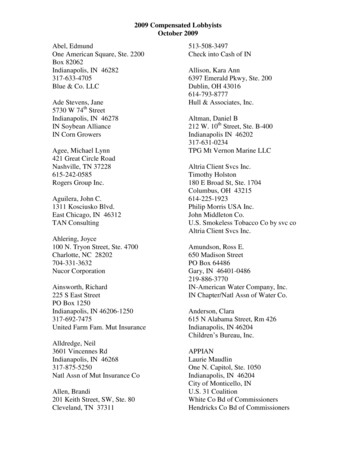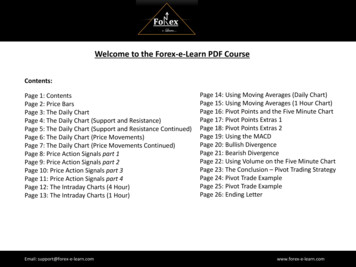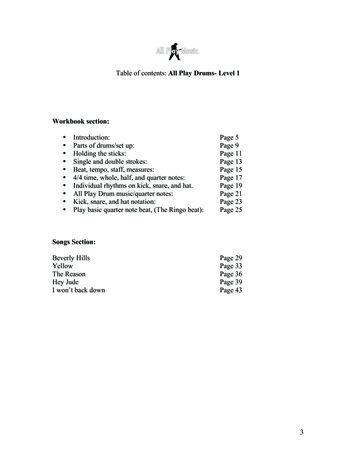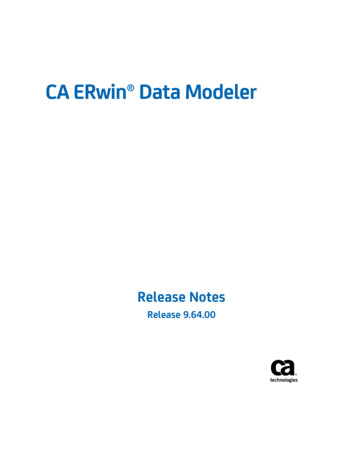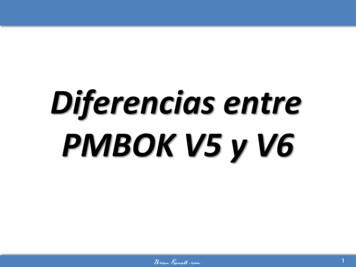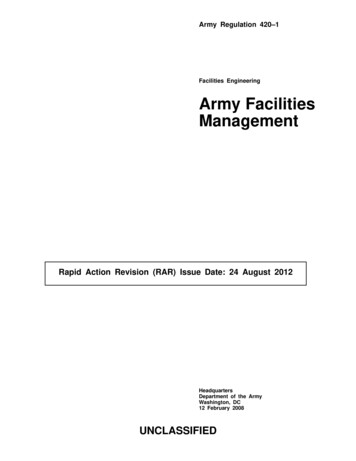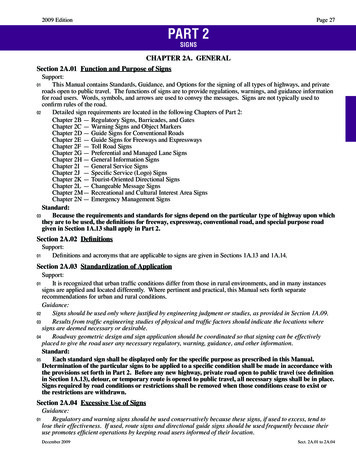
Transcription
2009 EditionPage 27PART 2SIGNSCHAPTER 2A. GENERALSection 2A.01 Function and Purpose of SignsSupport:01This Manual contains Standards, Guidance, and Options for the signing of all types of highways, and privateroads open to public travel. The functions of signs are to provide regulations, warnings, and guidance informationfor road users. Words, symbols, and arrows are used to convey the messages. Signs are not typically used toconfirm rules of the road.02Detailed sign requirements are located in the following Chapters of Part 2:Chapter 2B — Regulatory Signs, Barricades, and GatesChapter 2C — Warning Signs and Object MarkersChapter 2D — Guide Signs for Conventional RoadsChapter 2E — Guide Signs for Freeways and ExpresswaysChapter 2F — Toll Road SignsChapter 2G — Preferential and Managed Lane SignsChapter 2H — General Information SignsChapter 2I — General Service SignsChapter 2J — Specific Service (Logo) SignsChapter 2K — Tourist-Oriented Directional SignsChapter 2L — Changeable Message SignsChapter 2M — Recreational and Cultural Interest Area SignsChapter 2N — Emergency Management SignsStandard:03Because the requirements and standards for signs depend on the particular type of highway upon whichthey are to be used, the definitions for freeway, expressway, conventional road, and special purpose roadgiven in Section 1A.13 shall apply in Part 2.Section 2A.02 DefinitionsSupport:01Definitions and acronyms that are applicable to signs are given in Sections 1A.13 and 1A.14.Section 2A.03 Standardization of ApplicationSupport:01It is recognized that urban traffic conditions differ from those in rural environments, and in many instancessigns are applied and located differently. Where pertinent and practical, this Manual sets forth separaterecommendations for urban and rural conditions.Guidance:02Signs should be used only where justified by engineering judgment or studies, as provided in Section 1A.09.03Results from traffic engineering studies of physical and traffic factors should indicate the locations wheresigns are deemed necessary or desirable.04Roadway geometric design and sign application should be coordinated so that signing can be effectivelyplaced to give the road user any necessary regulatory, warning, guidance, and other information.Standard:05Each standard sign shall be displayed only for the specific purpose as prescribed in this Manual.Determination of the particular signs to be applied to a specific condition shall be made in accordance withthe provisions set forth in Part 2. Before any new highway, private road open to public travel (see definitionin Section 1A.13), detour, or temporary route is opened to public travel, all necessary signs shall be in place.Signs required by road conditions or restrictions shall be removed when those conditions cease to exist orthe restrictions are withdrawn.Section 2A.04 Excessive Use of SignsGuidance:Regulatory and warning signs should be used conservatively because these signs, if used to excess, tend tolose their effectiveness. If used, route signs and directional guide signs should be used frequently because theiruse promotes efficient operations by keeping road users informed of their location.01December 2009 Sect. 2A.01 to 2A.04
Page 282009 EditionSection 2A.05 Classification of SignsStandard:01Signs shall be defined by their function as follows:A. Regulatory signs give notice of traffic laws or regulations.B. Warning signs give notice of a situation that might not be readily apparent.C. Guide signs show route designations, destinations, directions, distances, services, points of interest,and other geographical, recreational, or cultural information.Support:02Object markers are defined in Section 2C.63.Section 2A.06 Design of SignsSupport:01This Manual shows many typical standard signs and object markers approved for use on streets, highways,bikeways, and pedestrian crossings.02In the specifications for individual signs and object markers, the general appearance of the legend, color, andsize are shown in the accompanying tables and illustrations, and are not always detailed in the text.03Detailed drawings of standard signs, object markers, alphabets, symbols, and arrows (see Figure 2D-2) areshown in the “Standard Highway Signs and Markings” book. Section 1A.11 contains information regarding howto obtain this publication.04The basic requirements of a sign are that it be legible to those for whom it is intended and that it beunderstandable in time to permit a proper response. Desirable attributes include:A. High visibility by day and night; andB. High legibility (adequately sized letters, symbols, or arrows, and a short legend for quick comprehensionby a road user approaching a sign).05Standardized colors and shapes are specified so that the several classes of traffic signs can be promptlyrecognized. Simplicity and uniformity in design, position, and application are important.Standard:06The term legend shall include all word messages and symbol and arrow designs that are intended toconvey specific meanings.07Uniformity in design shall include shape, color, dimensions, legends, borders, and illumination orretroreflectivity.08Standardization of these designs does not preclude further improvement by minor changes in theproportion or orientation of symbols, width of borders, or layout of word messages, but all shapes andcolors shall be as indicated.09All symbols shall be unmistakably similar to, or mirror images of, the adopted symbol signs, all ofwhich are shown in the “Standard Highway Signs and Markings” book (see Section 1A.11). Symbolsand colors shall not be modified unless otherwise provided in this Manual. All symbols and colors forsigns not shown in the “Standard Highway Signs and Markings” book shall follow the procedures forexperimentation and change described in Section 1A.10.Option:10Although the standard design of symbol signs cannot be modified, the orientation of the symbol may bechanged to better reflect the direction of travel, if appropriate.Standard:11Where a standard word message is applicable, the wording shall be as provided in this Manual.12In situations where word messages are required other than those provided in this Manual, the signsshall be of the same shape and color as standard signs of the same functional type.Option:13State and local highway agencies may develop special word message signs in situations where roadwayconditions make it necessary to provide road users with additional regulatory, warning, or guidance information,such as when road users need to be notified of special regulations or warned about a situation that might not bereadily apparent. Unlike colors that have not been assigned or symbols that have not been approved for signs, newword message signs may be used without the need for experimentation.Sect. 2A.05 to 2A.06 December 2009
2009 EditionPage 29Standard:14Except as provided in Paragraph 16 and except for the Carpool Information (D12-2) sign(see Section 2I.11), Internet addresses and e-mail addresses, including domain names and uniform resourcelocators (URL), shall not be displayed on any sign, supplemental plaque, sign panel (including logo signpanels on Specific Service signs), or changeable message sign.Guidance:15Unless otherwise provided in this Manual for a specific sign, and except as provided in Paragraph 16,telephone numbers of more than four characters should not be displayed on any sign, supplemental plaque, signpanel (including logo sign panels on specific service signs), or changeable message sign.Option:16Internet addresses, e-mail addresses, or telephone numbers with more than four characters may be displayedon signs, supplemental plaques, sign panels, and changeable message signs that are intended for viewing onlyby pedestrians, bicyclists, occupants of parked vehicles, or drivers of vehicles on low-speed roadways whereengineering judgment indicates that an area is available for drivers to stop out of the traffic flow to read themessage.Standard:17Pictographs (see definition in Section 1A.13) shall not be displayed on signs except as specificallyprovided in this Manual. Pictographs shall be simple, dignified, and devoid of any advertising. When usedto represent a political jurisdiction (such as a State, county, or municipal corporation) the pictograph shallbe the official designation adopted by the jurisdiction. When used to represent a college or university, thepictograph shall be the official seal adopted by the institution. Pictorial representations of university orcollege programs shall not be permitted to be displayed on a sign.Section 2A.07 Retroreflectivity and IlluminationSupport:01There are many materials currently available for retroreflection and various methods currently available forthe illumination of signs and object markers. New materials and methods continue to emerge. New materials andmethods can be used as long as the signs and object markers meet the standard requirements for color, both by dayand by night.Standard:Table 2A-1. Illumination of Sign Elements02Regulatory, warning, and guide signsand object markers shall be retroreflectiveMeans of IlluminationSign Element to be Illuminated(see Section 2A.08) or illuminated to show Symbol or word messagethe same shape and similar color by both BackgroundLight behind the sign faceday and night, unless otherwise provided Symbol, word message, and background(through a translucent material)in the text discussion in this Manual for aparticular sign or group of signs.Attached or independentlymounted light source designed Entire sign face03The requirements for sign illuminationto direct essentially uniformillumination onto the sign faceshall not be considered to be satisfied bystreet or highway lighting. Symbol or word messageLight emitting diodes (LEDs) Portions of the sign borderOption:Other devices, or treatments that04Sign elements may be illuminated by thehighlight the sign shape, color, ormessage:means shown in Table 2A-1. Symbol or word messageLuminous tubing Entire sign faceFiber optics05Retroreflection of sign elements mayIncandescent light bulbsbe accomplished by the means shownLuminescent panelsin Table 2A-2.06Light Emitting Diode (LED) units mayTable 2A-2. Retroreflection of Sign Elementsbe used individually within the legend orsymbol of a sign and in the border of aMeans of RetroreflectionSign Elementsign, except for changeable message signs,Symbolto improve the conspicuity, increase theReflector “buttons” or similar unitsWord messagelegibility of sign legends and borders, orBorderprovide a changeable message.SymbolA material that has a smooth, sealed outersurface over a microstructure that reflects lightDecember 2009 Word messageBorderBackgroundSect. 2A.06 to 2A.07
Page 302009 EditionStandard:07Except as provided in Paragraphs 11 and 12, neither individual LEDs nor groups of LEDs shall beplaced within the background area of a sign.08If used, the LEDs shall have a maximum diameter of 1/4 inch and shall be the following colors based onthe type of sign:A. White or red, if used with STOP or YIELD signs.B. White, if used with regulatory signs other than STOP or YIELD signs.C. White or yellow, if used with warning signs.D. White, if used with guide signs.E. White, yellow, or orange, if used with temporary traffic control signs.F. White or yellow, if used with school area signs.09If flashed, all LED units shall flash simultaneously at a rate of more than 50 and less than 60 timesper minute.10The uniformity of the sign design shall be maintained without any decrease in visibility, legibility, ordriver comprehension during either daytime or nighttime conditions.Option:11For STOP and YIELD signs, LEDs may be placed within the border or within one border width within thebackground of the sign.12For STOP/SLOW paddles (see Section 6E.03) used by flaggers and the STOP paddles (see Section 7D.05) usedby adult crossing guards, individual LEDs or groups of LEDs may be used.Support:13Other methods of enhancing the conspicuity of standard signs are described in Section 2A.15.14Information regarding the use of retroreflective material on the sign support is contained in Section 2A.21.Section 2A.08 Maintaining Minimum RetroreflectivitySupport:Retroreflectivity is one of several factors associated with maintaining nighttime sign visibility(see Section 2A.22).Standard:02Public agencies or officials having jurisdiction shall use an assessment or management method that isdesigned to maintain sign retroreflectivity at or above the minimum levels in Table 2A-3.Support:03Compliance with the Standard in Paragraph 2 is achieved by having a method in place and using the methodto maintain the minimum levels established in Table 2A-3. Provided that an assessment or management methodis being used, an agency or official having jurisdiction would be in compliance with the Standard in Paragraph 2even if there are some individual signs that do not meet the minimum retroreflectivity levels at a particular pointin time.Guidance:04Except for those signs specifically identified in Paragraph 6, one or more of the following assessment ormanagement methods should be used to maintain sign retroreflectivity:A. Visual Nighttime Inspection—The retroreflectivity of an existing sign is assessed by a trained signinspector conducting a visual inspection from a moving vehicle during nighttime conditions. Signsthat are visually identified by the inspector to have retroreflectivity below the minimum levels shouldbe replaced.B. Measured Sign Retroreflectivity—Sign retroreflectivity is measured using a retroreflectometer. Signswith retroreflectivity below the minimum levels should be replaced.C. Expected Sign Life—When signs are installed, the installation date is labeled or recorded so that theage of a sign is known. The age of the sign is compared to the expected sign life. The expected sign lifeis based on the experience of sign retroreflectivity degradation in a geographic area compared to theminimum levels. Signs older than the expected life should be replaced.D. Blanket Replacement—All signs in an area/corridor, or of a given type, should be replaced at specifiedintervals. This eliminates the need to assess retroreflectivity or track the life of individual signs. Thereplacement interval is based on the expected sign life, compared to the minimum levels, for theshortest-life material used on the affected signs.01Sect. 2A.07 to 2A.08 December 2009
2009 EditionPage 31Table 2A-3. Minimum Maintained Retroreflectivity Levels1Sheeting Type (ASTM D4956-04)Sign ColorBeaded SheetingWhite on GreenBlack on Yellow orBlack on OrangePrismatic SheetingIIIIIIIII, IV, VI, VII, VIII, IX, XW*; G 7W*; G 15W*; G 25W 250; G 25AdditionalCriteriaOverheadW*; G 7W 120; G 15Post-mountedY*; O*Y 50; O 502Y*; O*Y 75; O 753White on RedW 35; R 74Black on WhiteW 50–The minimum maintained retroreflectivity levels shown in this table are in units of cd/lx/m2 measured at anobservation angle of 0.2 and an entrance angle of -4.0 .2For text and fine symbol signs measuring at least 48 inches and for all sizes of bold symbol signs3For text and fine symbol signs measuring less than 48 inches4Minimum sign contrast ratio 3:1 (white retroreflectivity red retroreflectivity)* This sheeting type shall not be used for this color for this application.1Bold Symbol Signs W1-1,2 – Turn and Curve W1-3,4 – Reverse Turn andCurve W1-5 – Winding Road W1-6,7 – Large Arrow W1-8 – Chevron W1-10 – Intersection in Curve W1-11 – Hairpin Curve W1-15 – 270 Degree Loop W2-1 – Cross Road W2-2,3 – Side Road W2-4,5 – T and Y Intersection W2-6 – Circular Intersection W2-7,8 – Double Side Roads W3-1 – Stop Ahead W3-2 – Yield Ahead W3-3 – Signal Ahead W4-1 – Merge W4-2 – Lane Ends W4-3 – Added Lane W4-5 – Entering Roadway Merge W4-6 – Entering RoadwayAdded Lane W6-1,2 – Divided HighwayBegins and Ends W6-3 – Two-Way Traffic W10-1,2,3,4,11,12 – GradeCrossing Advance Warning W11-2 – Pedestrian Crossing W11-3,4,16-22 – Large Animals W11-5 – Farm Equipment W11-6 – Snowmobile Crossing W11-7 – Equestrian Crossing W11-8 – Fire Station W11-10 – Truck Crossing W12-1 – Double Arrow W16-5P,6P,7P – Pointing ArrowPlaques W20-7 – Flagger W21-1 – WorkerFine Symbol Signs (symbol signs not listed as bold symbol signs)Special Cases W3-1 – Stop Ahead: Red retroreflectivity 7 W3-2 – Yield Ahead: Red retroreflectivity 7; White retroreflectivity 35 W3-3 – Signal Ahead: Red retroreflectivity 7; Green retroreflectivity 7 W3-5 – Speed Reduction: White retroreflectivity 50 For non-diamond shaped signs, such as W14-3 (No Passing Zone), W4-4P (Cross Traffic Does Not Stop), orW13-1P,2,3,6,7 (Speed Advisory Plaques), use the largest sign dimension to determine the proper minimumretroreflectivity level.E. Control Signs—Replacement of signs in the field is based on the performance of a sample of controlsigns. The control signs might be a small sample located in a maintenance yard or a sample of signs inthe field. The control signs are monitored to determine the end of retroreflective life for the associatedsigns. All field signs represented by the control sample should be replaced before the retroreflectivitylevels of the control sample reach the minimum levels.F. Other Methods—Other methods developed based on engineering studies can be used.Support:05Additional information about these methods is contained in the 2007 Edition of FHWA’s “Maintaining TrafficSign Retroreflectivity” (see Section 1A.11).Option:06Highway agencies may exclude the following signs from the retroreflectivity maintenance guidelines describedin this Section:A. Parking, Standing, and Stopping signs (R7 and R8 series)B. Walking/Hitchhiking/Crossing signs (R9 series, R10-1 through R10-4b)C. Acknowledgment signsD. All signs with blue or brown backgroundsE. Bikeway signs that are intended for exclusive use by bicyclists or pedestriansDecember 2009 Sect. 2A.08
Page 322009 EditionSection 2A.09 ShapesStandard:01Particular shapes,as shown in Table 2A-4,shall be used exclusivelyfor specific signs or seriesof signs, unless otherwiseprovided in the textdiscussion in this Manualfor a particular sign or classof signs.Section 2A.10 Sign ColorsTable 2A-4. Use of Sign ShapesShapeSignsOctagonStop*Equilateral Triangle (1 point down)Yield*CircleGrade Crossing Advance Warning*Pennant Shape/Isosceles Triangle(longer axis horizontal)No Passing*Pentagon (pointed up)School Advance Warning Sign (squared bottom corners)*County Route Sign (tapered bottom corners)*Crossbuck(two rectangles in an “X” configuration)Grade Crossing*DiamondWarning SeriesStandard:Regulatory Series01The colors to be usedRectangle (including square)Guide Series**Warning Serieson standard signs andtheir specific use on theseRecreational and Cultural Interest Area SeriesTrapezoidNational Forest Route Signsigns shall be as providedin the applicable Sections* This sign shall be exclusively the shape shown.of this Manual. The color** Guide series includes general service, specific service, tourist-oriented directional, generalcoordinates and valuesinformation, recreational and cultural interest area, and emergency management signs.shall be as described in 23CFR, Part 655, SubpartF, Appendix.Support:02As a quick reference, common uses of sign colors are shown in Table 2A-5. Color schemes on specific signsare shown in the illustrations located in each appropriate Chapter.03Whenever white is specified in this Manual or in the “Standard Highway Signs and Markings” book(see Section 1A.11) as a color, it is understood to include silver-colored retroreflective coatings or elements thatreflect white light.04The colors coral and light blue are being reserved for uses that will be determined in the future by the FederalHighway Administration.05Information regarding color coding of destinations on guide signs, including community wayfinding signs, iscontained in Chapter 2D.Option:06The approved fluorescent version of the standard red, yellow, green, or orange color may be used as analternative to the corresponding standard color.Section 2A.11 DimensionsSupport:The “Standard Highway Signs and Markings” book (see Section 1A.11) prescribes design details for up tofive different sizes depending on the type of traffic facility, including bikeways. Smaller sizes are designed tobe used on bikeways and some other off-road applications. Larger sizes are designed for use on freeways andexpressways, and can also be used to enhance road user safety and convenience on other facilities, especially onmulti-lane divided highways and on undivided highways having five or more lanes of traffic and/or high speeds.The intermediate sizes are designed to be used on other highway types.Standard:02The sign dimensions prescribed in the sign size tables in the various Parts and Chapters in thisManual and in the “Standard Highway Signs and Markings” book (see Section 1A.11) shall be used unlessengineering judgment determines that other sizes are appropriate. Except as provided in Paragraph 3,where engineering judgment determines that sizes smaller than the prescribed dimensions are appropriatefor use, the sign dimensions shall not be less than the minimum dimensions specified in this Manual. Thesizes shown in the Minimum columns that are smaller than the sizes shown in the Conventional Roadcolumns in the various sign size tables in this Manual shall only be used on low-speed roadways, alleys, andprivate roads open to public travel where the reduced legend size would be adequate for the regulation orwarning or where physical conditions preclude the use of larger sizes.01Sect. 2A.09 to 2A.11 December 2009
2009 EditionPage 33Table 2A-5. Common Uses of Sign XXXXXXXXPedestrianXXXBicycleXXXGuideXInterstate RouteXXState RouteXU.S. RouteXXXXXCounty RouteXXForest RouteXStreet NameXXDestinationXXReference LocationXInformationXXXXEvacuation RouteXXRoad User ServiceXXRecreationalXTemporaryTraffic ControlXXXXXXIncident ManagementXSchoolXETC-Account ackType of SignBackgroundOrangeLegendXXX****Changeable MessageSignsRegulatory*X***XXWarningXTemporary TrafficControlXXXXGuideXXMotorist ServicesXXIncident ManagementXSchool, Pedestrian,BicycleXXXX**X**XXFluorescent versions of these background colors may also be used.** These alternative background colors would be provided by blue or green lighted pixels such that the entire CMSwould be lighted, not just the legend.*** Red is used only for the circle and slash or other red elements of a similar static regulatory sign.**** The use of the color purple on signs is restricted per the provisions of Paragraph 1 of Section 2F.03.December 2009 Sect. 2A.11
Page 342009 EditionOption:03For alleys with restrictive physical conditions and vehicle usage that limits installation of the minimum sizesign (or the Conventional Road size sign if no Minimum size is shown), both the sign height and the sign widthmay be decreased by up to 6 inches.Guidance:04The sizes shown in the Freeway and Expressway columns in the various sign size tables in this Manualshould be used on freeways and expressways, and for other higher-speed applications based upon engineeringjudgment, to provide larger signs for increased visibility and recognition.05The sizes shown in the Oversized columns in the various sign size tables in this Manual size should beused for those special applications where speed, volume, or other factors result in conditions where increasedemphasis, improved recognition, or increased legibility is needed, as determined by engineering judgment orstudy.06Increases above the prescribed sizes should be used where greater legibility or emphasis is needed. If signslarger than the prescribed sizes are used, the overall sign dimensions should be increased in 6-inch increments.Standard:07Where engineering judgment determines that sizes that are different than the prescribed dimensionsare appropriate for use, standard shapes and colors shall be used and standard proportions shall beretained as much as practical.Guidance:08When supplemental plaques are installed with larger sized signs, a corresponding increase in the size ofthe plaque and its legend should also be made. The resulting plaque size should be approximately in the samerelative proportion to the larger sized sign as the conventional sized plaque is to the conventional sized sign.Section 2A.12 SymbolsStandard:Symbol designs shall in all cases be unmistakably similar to those shown in this Manual and in the“Standard Highway Signs and Markings” book (see Section 1A.11).Support:02New symbol designs are adopted by the Federal Highway Administration based on research evaluations todetermine road user comprehension, sign conspicuity, and sign legibility.03Sometimes a change from word messages to symbols requires significant time for public education andtransition. Therefore, this Manual sometimes includes the practice of using educational plaques to accompany newsymbol signs.Guidance:04New warning or regulatory symbol signs not readily recognizable by the public should be accompanied by aneducational plaque.Option:05Educational plaques may be left in place as long as they are in serviceable condition.06State and/or local highway agencies may conduct research studies to determine road user comprehension, signconspicuity, and sign legibility.Guidance:07Although most standard symbols are oriented facing left, mirror images of these symbols should be usedwhere the reverse orientation might better convey to road users a direction of movement.Standard:08A symbol used for a given category of signs (regulatory, warning, or guide) shall not be used for adifferent category of signs, except as specifically authorized in this Manual.09Except as provided in Paragraph 11, a recreational and cultural interest area symbol (see Chapter 2M)shall not be used on streets or highways outside of recreational and cultural interest areas.10A recreational and cultural interest area guide sign symbol (see Chapter 2M) shall not be used on anyregulatory or warning sign on any street, road, or highway.Option:11A recreational and cultural interest area guide sign symbol (see Section 2M.04) may be used on a highwayguide sign outside of a recreational and cultural interest area to supplement a comparable word message for whichthere is no approved symbol for that message in Chapters 2B through 2I or 2N.01Sect. 2A.11 to 2A.12 December 2009
2009 EditionPage 35Support:12Section 2M.07 contains provisions for the use of recreational and cultural interest area symbols to indicateprohibited activities or items in non-road applications.Section 2A.13 Word MessagesStandard:01Except as provided in Section 2A.06, all word messages shall use standard wording and letters as shownin this Manual and in the “Standard Highway Signs and Markings” book (see Section 1A.11).Guidance:02Word messages should be as brief as possible and the lettering should be large enough to provide thenecessary legibility distance. A minimum specific ratio of 1 inch of letter height per 30 feet of legibility distanceshould be used.03Abbreviations (see Section 1A.15) should be kept to a minimum.04Word messages should not contain periods, apostrophes, question marks, ampersands, or other punctuationor characters that are not letters, numerals, or hyphens unless necessary to avoid confusion.05The solidus (slanted line or forward slash) is intended to be used for fractions only and should not beused to separate words on the same line of legend. Instead, a hyphen should be used for this purpose, suchas “TRUCKS - BUSES.”Standard:06Fractions shall be displayed with the numerator and denominator diagonally arranged about thesolidus (slanted line or forward slash). The overall height of the fraction is measured from the top of thenumerator to the bottom of the denominator, each of which is vertically aligned with the upper and lowerends of the solidus. The overall height of the fraction shall be determined by the height of the numeralswithin the fraction, and shall be 1.5 times the height of an individual numeral within the fraction.Support:07The “Standard Highway Signs and Markings” book (see Section 1A.11) contains details regarding the layoutsof fractions on signs.Guidance:08When initials are used to represent an abbreviation for separate words (such as “U S” for a United Statesroute), the initials should be separated by a space of between 1/2 and 3/4 of the letter height of the initials.09When an Interstate route is displayed in text form instead of using the route shield, a hyphen should be usedfor clarity, such as “I-50.”Standard:10All sign lettering shall be in upper-case letters as provided in the “Standard Highway Signs andMarkings” book (see Section 1A.11), unless otherwise provided in this Manual for a particular sign or typeof message.11The sign lettering for names of places, streets, and highways shall be composed of a combination oflower-case letters with initial upper-case letters.Support:12Letter height is expressed in terms of the height of an upper-case letter. For mixed-case legends (thosecomposed of an initial upper-case letter followed by lower-case letters), the height of the lower-case letters isderived from the specified height of the initial upper-case letter based on a prescribed ratio. Letter heights formixed-case legends might be expressed in terms of both the upper- and lower-case letters, or in terms of the initialupper-case letter alone. When the height of a lower-case letter is specified or determined from the prescribed ratio,the reference is to the nominal loop height of the letter. The term loop height refers to the portion of a lower-caseletter that excludes any ascending
2009 Edition Page 29 December 2009 Sect. 2A.06 to 2A.07 Standard: 14 Except as provided in Paragraph 16 and except for the Carpool Information (D12-2) sign (see Section 2I.11), Internet addresses and e-ma




